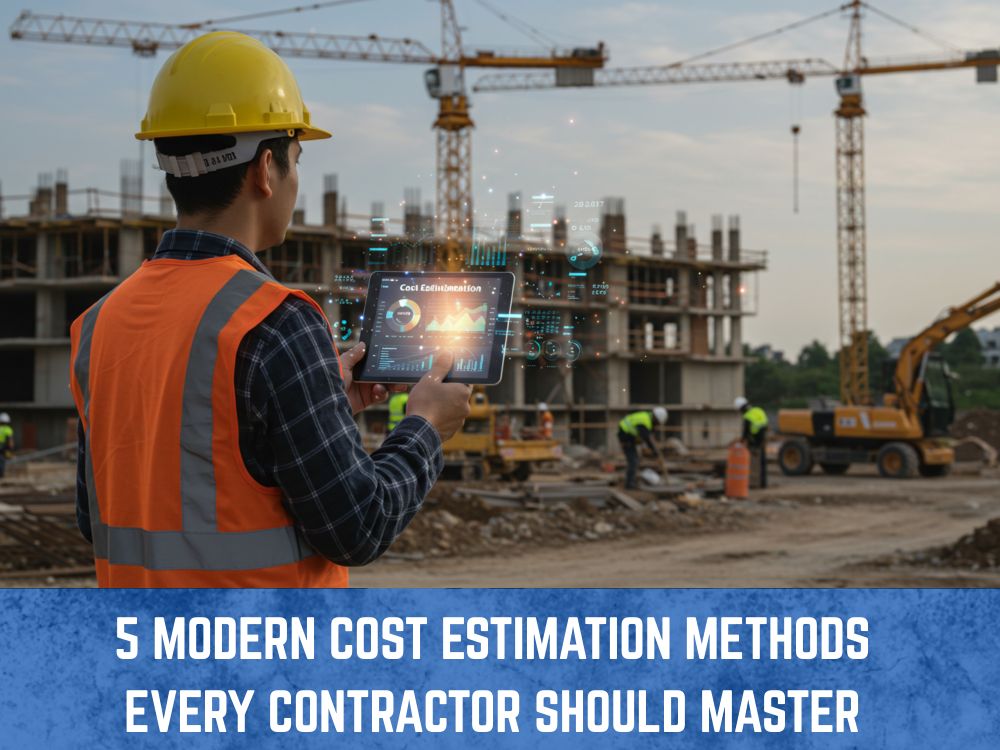Cost estimation is the bedrock of a profitable construction business. Without accurate estimates, a contractor risks underbidding and losing money, or overbidding and losing the job entirely. While traditional methods have served the industry for decades, the modern construction landscape—with its complex projects, fluctuating material costs, and tight schedules—demands a more strategic approach. Mastering these five modern cost estimation methods can give every contractor a competitive edge.
1. Parametric Estimation
Parametric estimation is a powerful technique that uses historical data and mathematical models to predict project costs. Instead of meticulously counting every nut and bolt, this method uses a unit rate derived from past projects. For example, a homebuilder might have historical data showing that a standard house costs a certain amount per square foot.
How it works:
You identify a key project metric (e.g., square footage, number of rooms, or linear feet) and multiply it by a cost per unit. This method is especially useful for early-stage estimates when design details aren’t finalized.
Advantages:
- Speed: It’s one of the fastest ways to generate a preliminary estimate.
- Simplicity: It’s easy to understand and explain to a client.
- Scalability: It works well for a wide range of project sizes.
Pro-Tip: For this method to be accurate, your historical data must be reliable and relevant to the current project’s scope.
2. Analogous Estimation
Similar to parametric estimation, analogous estimation relies on historical data but is less data-driven and more high-level. It involves comparing a new project to a similar past project to derive an estimate. This method is often used when there is limited detailed information available.
How it works:
You find a past project with a similar scope, size, and complexity. You then use its actual costs as the basis for your new project’s estimate. For instance, if you built a similar two-story office building two years ago, you would use that project’s total cost as a starting point, adjusting for inflation and any key differences.
Advantages:
- Quick: It’s a great method for a quick, rough estimate in the initial planning phase.
- Low Cost: It requires minimal effort and no specialized software.
Disadvantage:
This method is highly dependent on how similar the two projects are. It can be highly inaccurate if the analogy is not strong.
3. Bottom-Up Estimation
Often considered the most accurate method, bottom-up estimation involves a detailed breakdown of the entire project. This is the opposite of a top-down approach. You start by identifying every single task, material, and labor hour, and then you add up the costs to get a grand total.
How it works:
You create a Work Breakdown Structure (WBS) that breaks the project into smaller, manageable tasks. For each task, you estimate the cost of materials, labor, and equipment. For example, for a “Framing Walls” task, you would list the quantity and cost of every 2×4, sheet of plywood, and nail, as well as the number of labor hours required for that specific task.
Advantages:
- High Accuracy: Because every cost is accounted for, this method provides the most precise estimate.
- Risk Mitigation: It helps in identifying potential cost overruns and areas of risk.
Disadvantage:
It is the most time-consuming and labor-intensive method, making it less suitable for preliminary bids.
4. Three-Point Estimation
This method helps to account for uncertainty and risk in project estimates. Instead of providing a single number, you provide three different estimates for each cost item: an optimistic, a pessimistic, and a most likely cost.
How it works:
You use a formula to calculate an average estimate that weighs the three scenarios. The most common formula is PERT (Program Evaluation and Review Technique):
Estimate = (Optimistic + 4 x Most Likely + Pessimistic) / 6
- Optimistic (O): The best-case scenario, assuming everything goes perfectly.
- Most Likely (M): The most realistic cost, based on normal conditions.
- Pessimistic (P): The worst-case scenario, accounting for unexpected problems or delays.
Advantages:
- Manages Uncertainty: This method acknowledges that projects are subject to variables and provides a more realistic range of potential outcomes.
- Better Risk Assessment: It helps in identifying and planning for potential project risks.
5. Cost-Loaded Schedule Estimation
This advanced method integrates project scheduling with cost estimation. It’s a dynamic approach where costs are tied to the timeline of the project. By linking a cost to each task in a project schedule (like a Gantt chart), a contractor can see when and where expenses will occur.
How it works:
You create a detailed project schedule that includes every task and its duration. Then, you “load” each task with its associated cost for labor, materials, and equipment. The total cost is a running sum of these individual task costs, updated as the project progresses.
Advantages:
- Cash Flow Management: It gives a clear picture of when money will be spent, helping with financial planning.
- Progress Tracking: It allows you to monitor not only a project’s schedule but also its budget in real-time.
- Client Communication: It provides a clear, transparent view of project spending, which builds client trust.
Disadvantage:
It requires sophisticated project management software and a high level of detail, making it more complex to set up.
Conclusion
No single estimation method is a one-size-fits-all solution. The most successful contractors often use a combination of these methods depending on the project phase and level of detail required. For a quick initial bid, a parametric or analogous estimate might be sufficient. As the project moves into the planning phase, a detailed bottom-up estimate provides the necessary accuracy. For high-stakes projects with a lot of uncertainty, a three-point estimate can provide a more realistic range, while a cost-loaded schedule is the ultimate tool for ongoing project and financial management. By mastering these modern techniques, you can ensure your bids are not only competitive but also profitable, securing the financial health and long-term success of your business.



